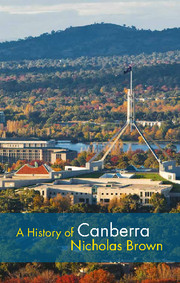Conclusion
Published online by Cambridge University Press: 05 July 2014
Summary
A child, just learning to talk, points from her pram as she is pushed towards the Floriade NightFest, at the sudden swell of colour and the roar of flame in the belly of a hot air balloon. ‘Skywhale!’ she exclaims. And there it is by the lake shore: a bright orange swag of fabric, slowly taking shape, its 10 pendulous breasts filling and its lips, against the Canberra twilight, the august National Library spotlit in the background.
The child was about to move with a crowd into a night-time viewing of Canberra’s annual festival of flowers, this year featuring a laser-lit spectacular in a gentle glade originally conceived in 1965 by Dame Sylvia Crowe, eminent British landscape architect, to help meld the Griffins’ long-delayed lake into a city that had taken a different course. Crowe’s commission was not without its own provocation, as part of a tussle between the National Capital Development Commission and the Commonwealth Department of the Interior over whether an Australian (so the latter maintained), and even a local, could have done the job as well and cheaper. In the endless theatre of Canberra, Skywhale had also been controversial since its unveiling. It had been commissioned by Robyn Archer, the creative director of the yearlong festival to celebrate 100 years since Canberra’s foundation. It was the creature of multimedia artist Patricia Piccinini, born in Sierra Leone, a graduate in Economic History from the Australian National University and then of the Victorian College of the Arts. Her balloon was seen as an indulgence, an exemplar of a contracting-out culture. (It was paid for, but not owned, by the Australian Capital Territory government – and the price itself was the subject of some fudging.) As some wits commented, it was a perfect symbol for a city ‘always on the tit’. But that child embraced it as a familiar thing, and entered into its fantasy. And to that extent she verified Piccinini’s rationale – to provide a figure that would engage people with the puzzle of evolution: things that find their course through chance, impact and adaptation over time.
- Type
- Chapter
- Information
- A History of Canberra , pp. 247 - 251Publisher: Cambridge University PressPrint publication year: 2014



